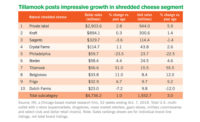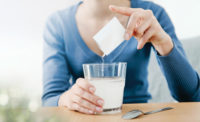
Natural Growth
By Lynn Petrak
Contributing Editor
Organic dairy continues to expand across multiple product categories.
If they believe the grass
is greener on the other side, then those seeking organic alternatives to
traditional dairy products are looking not just at the grass itself on
which dairy cows graze but at how the animals are treated.
Indeed, the on-farm life of the cow and what happens
to the milk as it makes its way through the processing stage has emerged
from something that was barely pondered a decade ago to a front-burner
issue. Was the animal allowed to roam on green pastures? Did the cow eat
grass or grain that was treated with pesticides? Was the cow treated with
synthetic growth hormones? What happens to the milk and finished product as
it goes through the manufacturing process?
Those are questions that consumers seem to be asking
more, as organic continues to segue beyond a small niche to a market force
with which to be reckoned. “There is a lot of interest,”
reports Barbara Haumann, press secretary for the Organic Trade Association
(OTA), Greenfield, Mass. “When you look at all the categories of
organic, fruit and vegetables are the leading ones, followed by
dairy.”
According to Karen Peckham, education information
specialist with the Madison, Wis.-based International Dairy Deli Bakery
Association (IDDBA), a distinctive alignment of trends is behind the
organic momentum. “Consumers are on a big health and wellness crusade
for themselves and the planet. They want to preserve or improve their own
health with a nutrition-packed diet and more ‘natural,’
unadulterated products, and organics are one way to do this,” she
says. “The growth of organic products is also a result of
consumers’ concern for how their food is produced and the
environmental impact of production.”
Organic dairy companies also indicate these types of
products are gaining traction. “Certainly, the percentage of products
that are organic have gone up virtually every year. I don’t think
anyone really knew how big it could be,” says Tim Kenny, senior vice
president of sales and marketing for Londonderry, N.H.-based Stonyfield
Farm, recalling the company’s early days. “There has been a
12-fold increase across the last 12 years, since we introduced our first
certified organic yogurt in 1995.”
Other organic dairy producers share a similar view.
“The whole organic industry is growing by leaps and bounds. From an
educational standpoint, consumers are becoming more aware of issues
surrounding their food,” says Jamie Johnson, community relations
manager for La Farge, Wis.-based Organic Valley Family of Farms, which
offers a slew of organic dairy products, along with organic eggs, produce
and soy-based foods and beverages. “I think it spans across a number
of groups — it’s moms for sure, but it’s young people,
too, and people who have a particular interest in health, whether
it’s for athleticism or an actual health issue they are struggling
with.”
Bob Laffranchi, founder of organic cheese manufacturer
Loleta Cheese Factory, Loleta, Calif., says greater educational efforts
have helped spur sales of his company’s organic cheeses in recent
years. “Now, there has been enough exposure to and understanding of
what organic really it is, that there is a sustainable market out
there,” he says.
Breaking it down by the numbers, demand is on the rise.
According to the latest manufacturer survey from the OTA, sales of organic
foods in the United States topped $14 billion in 2005, comprising 2.5
percent of total food sales, compared to 1.9 percent in 2003. Within the
general category, organic dairy sales hit the $2.1 billion mark in 2005.
While figures for 2006 will be available later this
summer, Haumann says, predictions are for dairy product sales to continue
to grow. Previous OTA estimates were for total organic food sales to near
$16 billion for the beginning of 2007.
Within organic dairy, milk remains the largest and most
dynamic segment. “In dairy, the leading area is milk and cream; that
was about half of the dairy segment in 2005 and we are sure it has grown
considerably,” Haumann reports. “Most mainstream supermarkets
offer at least one brand, if not two or three or four.”
Of the top 10 overall whole milk brands, Horizon
Organic leads the pack — second only to private label — with
$50 million in sales, according to Information Resources Inc. data from
earlier this year.
Stan Kostman, senior advisor for New York-based
Beverage Marketing Corp., says organic milk seems to be coming into its own
as a segment, for reasons relating to nutrition, to the fact that milk
ultimately is an animal-based drink. “Among beverages, milk is among
the most original natural beverages, so organic may connect that
way,” he says.
Following milk, Haumann says yogurt is the second most in-demand organic dairy product.
At Stonyfield Farm, Kenny agrees that consumers tend
to lean toward organic dairy offerings. “Dairy is an entry point,
because they are foods where people can see a connection to the
land,” he says, noting that yogurt also enjoys a particular halo for
its health benefits. “There is a fit with yogurt and general health.
It’s a category that people are gravitating toward because it’s
seen as a healthier food and its consumers are more likely to be people who
would be responsive to a message of organic.”
Meanwhile, although milk and yogurt are tops in the
organic dairy category, varieties of organic cheese, ice cream and other
cultured products like sour cream and cottage cheese are starting to
resonate with buyers. “For us, milk is what really took off for back
in the mid-1990s but we also sell cheese and butter,” Johnson says.
“They are growing categories that have a lot of potential.”
Peckham concurs that many dairy items ultimately can
benefit from the organic boom. “It appears that all organic dairy
products are in a good position for growth. In IDDBA’s What’s
in Store 2007 trends report, in which Euromonitor International forecasts
U.S. dairy products’ growth from 2005 to 2010, the organic categories
of milk, cheese, cream, yogurt and chilled/shelf-stable desserts were
predicted to have a compound annual growth rate of around 12
percent,” she says.
As demand flourishes, basic economic theory dictates
that supply is a key driver of any category’s strength and expansion.
To that end, the supply of organic milk is finally opening up after a tight
market situation.
“According to industry estimates, we expect
record organic milk supply growth this spring. For the last few years,
organic milk supplies barely kept up with consumer demand, which increased
by double digits from year to year,” says Sara Unrue, spokesperson
for Colorado-based Horizon Organic, the Dean Foods-owned brand that offers
a host of organic dairy products, from single-serve milk to cheese and ice
cream. “This trend creates significant opportunities and challenges
for the organic milk industry.”
Boon to Products
Again, as simple economics has proven, with growing
supply comes greater product development. Now that the organic milk supply
is catching up and product is literally flowing through their operations,
organic dairy companies are busy adding to their product lines.
In the milk sector, Unrue says supply has helped open
up new R&D avenues at Horizon Organic. “With plenty of milk
available, for the first time ever, this creates new opportunities for
product expansion and innovation. In June, Horizon Organic will launch Milk
Plus DHA, which is first to market within the organic industry,” she
reports.
Organic Valley also has welcomed the influx of milk.
“The beauty of the milk oversupply, if you will, is that we are able
to work on our aged cheeses and put out new products,” Johnson says.
Among those new products: a reduced-fat, lactose-free organic milk,
single-serve organic milks in strawberry and vanilla varieties and a
re-launched European-style organic butter.
Stonyfield Farm, for its part, is also working to
expand its range of organic offerings. “We are now up to 85 percent
organic and can see the point where we will be 100 percent,” Kenny
says of his company’s product line, pointing to the recent conversion
of the brand’s 32-ounce smoothie line to organic.
Beyond broadening product lines, Stonyfield Farm is
working to increase its distribution. “In the Northeast, we have 35
to 40 items in a store, but in the Western half the country, we have a more
minimal presence,” Kenny says, adding that the company is pursuing
growth opportunities in the Midwest as well.
In the cheese segment, Laffranchi says Loleta is set to
introduce new varieties to complement its roster of cheddar and Monterey
Jack cheeses. “Soon to come out will be an organic fontina and
organic havarti,” he says.
In addition to dairy companies that have specialized in
organic for years, other manufacturers, including major national brands,
are making room for organic versions of their products. Ben &
Jerry’s, the South Burlington, Vt.-based unit of Unilever, for
example, last year rolled out a line of organic ice cream in four
varieties. Kraft Foods, Northfield, Ill., added a new organic macaroni and
cheese product, made with certified organic cheddar cheese and pasta.
As for the future of organic, some say the category is
entering a new phase. “Consumers are starting to look at more
value-added products, looking even deeper at organic,” Johnson says,
citing queries on the company’s animal welfare guidelines,
sustainable packaging and other issues.
Laffranchi sees a similar trend. “Organic is
truly a standard of producing a product, but the new thing people are
talking about now is, ‘Can we associate a higher food value with
it?’ or ‘By producing a product in a certain way, can we
influence the nutritional properties or nutrient density?’” he
says. “That is where the organic movement is starting to go. I think
it’s exciting.”
Lynn Petrak is a freelance journalist based in the
Chicago area.
$OMN_arttitle="Natural Growth";?>
$OMN_artauthor="Lynn Petrak";?>


